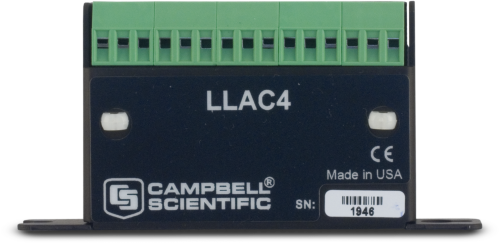
Increases number of signals data logger can monitor






Visão Geral
The LLAC4 is a small peripheral that you can use to increase the number of low-level ac signals that your data logger can monitor. The LLAC4 is often used to measure up to four anemometers, and it is especially useful for wind profiling applications.
Leia maisBenefícios e Características
- Ideal for applications that require high numbers of pulse channels, but fewer control ports, such as in wind prospecting
imagens



3D / CAD Files:
Descrição Técnica
The LLAC4 enables four data logger control ports to emulate pulse-counting channels by converting the low-level ac signals to logic levels read by the control ports. To use the LLAC4, the data logger control ports must accept high frequency pulses. The LLAC4 typically measures anemometers but can measure other sensors that output pulse counting signals.
Minimum AC Input Voltage versus Output Square Wave Frequency
| Input Sine Wave (mV RMS) |
Output Range (Hz) |
| 20 | 1.0 to 20 |
| 200 | 0.5 to 200 |
| 2000 | 0.3 to 10,000 |
| 5000 | 0.3 to 20,000 |
Compatibilidade
Please note: The following shows notable compatibility information. It is not a comprehensive list of all compatible products.
Data Loggers
| Product | Compatible | Note |
|---|---|---|
| 21X (retired) | ||
| CR10 (retired) | ||
| CR1000 (retired) | ||
| CR1000X (retired) | ||
| CR1000Xe | ||
| CR10X (retired) | ||
| CR200X (retired) | To be compatible with the CR200X, the low-level ac signals must not exceed 1 kHz. | |
| CR206X (retired) | To be compatible with the CR206X, the low-level ac signals must not exceed 1 kHz. | |
| CR211X (retired) | To be compatible with the CR211X, the low-level ac signals must not exceed 1 kHz. | |
| CR216X (retired) | To be compatible with the CR216X, the low-level ac signals must not exceed 1 kHz. | |
| CR23X (retired) | ||
| CR295X (retired) | To be compatible with the CR295X, the low-level ac signals must not exceed 1 kHz. | |
| CR300 (retired) | ||
| CR3000 (retired) | ||
| CR310 | ||
| CR350 | ||
| CR500 (retired) | ||
| CR5000 (retired) | ||
| CR510 (retired) | ||
| CR6 | ||
| CR800 (retired) | ||
| CR850 (retired) | ||
| CR9000 (retired) | ||
| CR9000X (retired) | It is necessary to use the CR9071E module with the CR9000X and LLAC4. |
Sensors
| Product | Compatible | Note |
|---|---|---|
| 014A-L | ||
| 03002-L | ||
| 03101-L | ||
| 034B-L (retired) | ||
| 05103-45-L (retired) | ||
| 05103-L | ||
| 05106-L (retired) | ||
| 05305-L | ||
| #40C |
Additional Compatibility Information
Data Logger Considerations
The LLAC4 works only with data loggers whose control ports can accept high frequency pulses. The CR23X has four control ports that can be used (5, 6, 7, and 8); the CR200X-series control ports are compatible but are limited to inputs of 1 kHz.
Sensors
The LLAC4 typically measures anemometers. Compatible anemometers include the Wind Monitors, 03002 Wind Sentry Set, and 03101 Wind Sentry Anemometer. (The 014A Anemometer and 034B Windset are not compatible.) The LLAC4 can also measure other sensors that output pulse counting signals.
Especificações
| Function | Increases the number of low-level ac signals that a data logger can monitor. |
| Number of Channels | 4 |
| Power | 0.1 mA (@ 12 Vdc) |
| Input Hysteresis | 16 mV (@ 1 Hz) |
| AC Coupling Removal of DC Offset | ≤ ±0.5 V |
| Maximum AC Input Voltage | ±20 V |
| Cable Length | 0.6 m (2 ft) |
| Dimensions |
|
| Weight | 92 g (3.2 oz) |
Documentos Relacionados
Lâminas do produto
Conformidade
Downloads
LLAC4 Program Example (2 KB) 21-05-2024
Description: Includes two programs, one for a CR1000X and one for a CR350. Both programs measure three different wind speed sensors that produce low-level AC signals. The sensors used are the RM Young 05103 and RM Young 05305 propeller-type anemometers, as well as the RM Young 03101 cup anemometer.
Perguntas Frequentes Relacionadas
Number of FAQs related to LLAC4: 1
-
No. But using a LLAC4 will convert the ac signal for up to four 03101-L sensors (and other ac output anemometers) to individual 0 to 5 Vdc TTL level square wave outputs. For more information, see the LLAC4 specification information.
listado em
- #40C - Maximum Wind Speed Sensor
- 05305-L - RM Young Wind Monitor AQ
- 05103-L - Wind Monitor
- 05106-L - Wind Monitor, Marine Version
- 03101-L - Wind Sentry Anemometer
- 03002-L - Wind Sentry Set
- 05103-45-L - Wind Monitor, Alpine Version
- 32123 - Wind Monitor-HD
- 32126 - Wind Monitor-HD, Alpine Version
- P2546C-L - Three-Cup Anemometer with MEASNET Calibration (coil version)